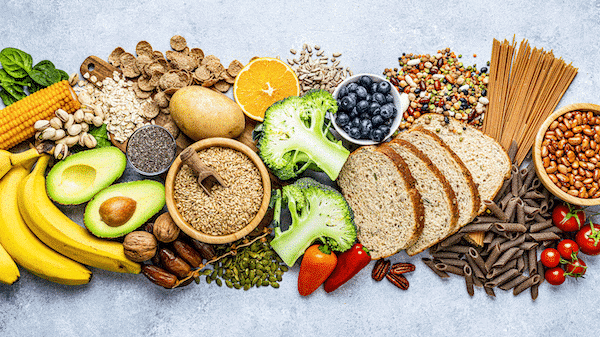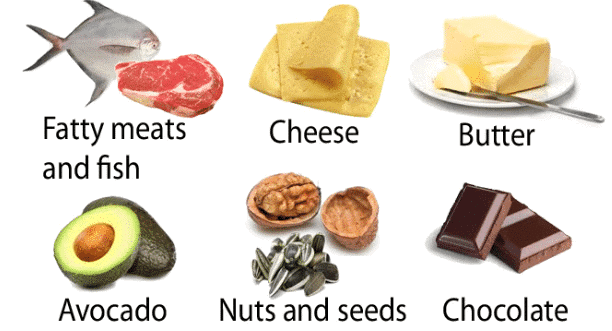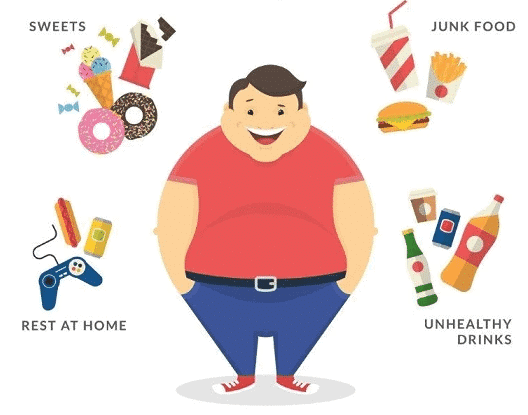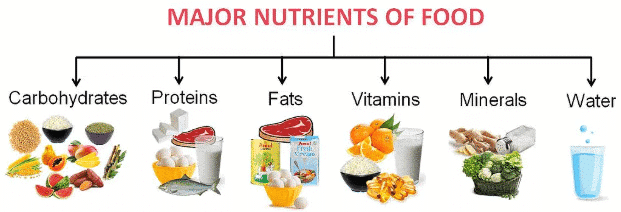Short & Long Question Answers: Mindful Eating: A Path to a Healthy Body | Short & Long Answer Questions for Class 6 PDF Download
Short Question Answers
Q1. What are nutrients? Name major nutrients.
Ans: The components of food that our body needs for growth and development are called nutrients. The major nutrients include:
- Carbohydrates
- Fats
- Proteins
- Vitamins
- Minerals
- Water
Q2. What are the functions of carbohydrates?
Ans: Carbohydrates play a vital role in meeting the energy requirements of the body. They are often referred to as energy-providing foods because they are the main source of energy for various bodily functions.
 Carbohydrate Rich FoodQ3. What are the functions of proteins?
Carbohydrate Rich FoodQ3. What are the functions of proteins?
Ans: Proteins are essential nutrients that play a crucial role in the body. They are often referred to as body-building foods because they aid in the growth and repair of damaged cells and tissues. Additionally, proteins help our body to fight infections and are vital for the development of our nails, hair, and muscles.
Q4. What are fats? Name some fat-containing substances.
Ans: Fats are energy-rich sources of food that provide essential energy to the body. They play a crucial role in various bodily functions. Common fat-containing substances include:
- Nuts
- Mustard seeds
- Milk
- Butter
Like carbohydrates, fats also contain carbon, hydrogen, and oxygen; however, fats contain less oxygen than carbohydrates.
 Fat Rich food
Fat Rich food
Q5. People who eat seafood do not suffer from Goitre. Explain.
Ans: People who consume seafood are less likely to suffer from goitre. This is because seafood is a rich source of iodine, and goitre is a deficiency disease that occurs due to a lack of iodine in the diet.
Q6. Write the functions of water in our body.
Ans: Water plays a vital role in our bodies by:
- Helping to absorb nutrients from food.
- Facilitating the removal of waste through urine and sweat.
- Being sourced from various liquids, as well as fruits and vegetables.
Q7. What is obesity?
Ans: Obesity is a condition that occurs when a person consumes an excessive amount of fat-containing foods. This leads to the accumulation of fat in the body, which can negatively impact health. obesity
obesity
Q8. A patient had stunted growth, swelling on face, discolouration of hair and skin disease. Doctor advised him to eat a lot of pulses, grams, egg white, milk etc. What is wrong with the patient? Explain.
Ans: The patient's symptoms, which include stunted growth, swelling on the face, discolouration of hair, and a skin disease, suggest a significant issue with their diet. These indications are likely caused by a deficiency of protein. The doctor has advised the patient to increase their intake of nutritious foods such as pulses, grams, egg white, and milk to address this deficiency. Without adequate protein, the body struggles to maintain essential functions, which can lead to the observed symptoms.
Q9. A small child became very thin and lean and later he became so weak that he could not move. Which nutrients should he eat so as to improve his health?
Ans: To improve health, a small child who has become very thin and weak should focus on consuming carbohydrates and proteins. These nutrients are essential for restoring energy levels and rebuilding muscle mass.
- Carbohydrates: Provide the body with energy. Foods such as rice, bread, and pasta are good sources.
- Proteins: Essential for growth and repair. Sources include meat, fish, eggs, dairy products, and legumes.
Q10. What are the functions of minerals?
Ans: Minerals are naturally occurring protective components of food that our body requires in small amounts. They are essential for the proper growth of the body and for maintaining good health. However, minerals do not provide energy. The main sources of minerals include:
- Milk
- Salt
- Eggs
- Green leafy vegetables
 Mineral rich food
Mineral rich food
Long Question Answers
Q1. List various types of nutrients and write the functions of each.
Ans: The various types of nutrients are:
- Carbohydrates: These are primarily energy-providing nutrients.
- Fats: They provide energy for the body and yield significantly more energy than carbohydrates when consumed in the same amount.
- Proteins: Known as body-building foods, proteins aid in the formation and repair of body parts. They are essential for skin, hair, muscles, and enzymes.
- Vitamins: Vitamins help protect our body against diseases and safeguard our eyes, bones, teeth, and gums.
- Minerals: These are essential for proper body growth and are vital for maintaining good health.
Q2. What is a balanced diet? Write the components of balanced diet.
Ans: A balanced diet is one that provides the right proportions of all the nutrients our body needs, along with roughage and water. The main components of a balanced diet include:
- Carbohydrates
- Fats
- Proteins
- Vitamins
- Minerals
- Roughage
- Water
Incorporating these components ensures overall health and well-being.
Q3. Excess intake of fats is harmful for the body because it causes obesity. Would it be harmful for the body to take too much of proteins or vitamins in the diet?
Ans: Yes, excessive intake of proteins and vitamins in the diet can be harmful and may lead to various health issues. Here are some points to consider:
- Excess protein can strain the kidneys and may lead to dehydration.
- High protein consumption may increase the risk of heart disease due to increased saturated fat intake from animal sources.
- Overconsumption of certain vitamins, particularly fat-soluble vitamins (A, D, E, and K), can result in toxicity.
- Important minerals can be displaced in the body, leading to imbalances.
It is essential to maintain a balanced diet to ensure proper health and avoid the risks associated with overconsumption of any nutrient.
Q4. How can you test presence of proteins in a given food item?
Ans: To test for the presence of proteins in a given food item, follow these steps:
- Take a small quantity of the food item. If the sample is solid, grind it into a fine powder.
- Place a portion of the sample into a clean test tube.
- Add 10 drops of water to the test tube and shake it well.
- Using a dropper, add two drops of copper sulphate solution and 10 drops of caustic soda solution to the test tube.
- Shake the test tube thoroughly and then place it in a test tube stand for a few minutes.
Observe the colour of the contents in the test tube. If the colour turns violet, this indicates that the food item contains proteins.
Note: Copper sulphate and caustic soda solutions are harmful. Handle them with care. In summary:
- Food + water + copper sulphate + caustic soda → violet colour → protein is present.
 Test of ProteinQ5. Write test for detecting the presence of starch.
Test of ProteinQ5. Write test for detecting the presence of starch.
Ans: To test for the presence of starch, follow these steps:
- Take a small piece of the food item.
- Add 2-3 drops of dilute iodine solution onto the sample.
If the colour of the food item changes to blue-black, this indicates that starch is present.
- Food + Iodine — Blue-black colour (starch present)
- Food + Iodine — No blue-black colour (no starch present)
FAQs on Short & Long Question Answers: Mindful Eating: A Path to a Healthy Body - Short & Long Answer Questions for Class 6
| 1. What is mindful eating? |  |
| 2. What are the benefits of mindful eating? |  |
| 3. How can someone practice mindful eating in daily life? |  |
| 4. Can mindful eating help with weight loss? |  |
| 5. Are there any challenges to practicing mindful eating? |  |






















